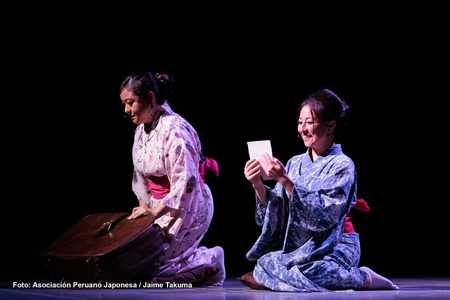It began as a play and then became an intergenerational manifesto through the “Nikkei Letters of the Bicentennial” contest, whose objective was to document the feelings of the members of the Peruvian-Japanese community about the 200 years of the Independence of Peru. One of its youngest members, the Nikkei playwright Daniel Goya, had had a predecessor idea that he turned into the staging “ Letters from the Bicentennial ,” presented at the National Library of Peru.
Subtitled “Theatrical scenes and a time capsule”, the work sought to unite 100 years of themes and stories that surround Peruvians; his way of thinking and his vision of each era. It was presented in August 2021, evoking the distant 1921 and the future 2121, with a dozen actors and one objective: to collect letters that will be preserved to be opened in 100 years. His reflective desire and Daniel's connection with the Nikkei community made it easier to create a version that represented the migrants from the country of the rising sun.
At the beginning of 2022, the three-act work “ Nikkei Letters of the Bicentennial ” was presented at the Peruvian-Japanese Association, written by Goya himself, featuring the Nikkei actors Wenddy Nishimazuruga Méndez, Seiji Igei Kohatsu, Gustavo Barreda Fudimoto and Cindy Nishimazuruga. replacing Biviana Goto Sánchez, for a reduced audience due to the pandemic.
“I had known Wendy for years and then they introduced us to more actors. That's how I met Seiji, Gustavo and then Cindy. It has been a wonderful team with whom we share hobbies and dreams. It is incredible to have a team that supports you and believes in your work,” says Daniel, who would see them again in April 2023 for the staging of a new version of the play titled “Nikkei Postcards,” at the Peruvian Japanese Theater. .

Fiction and reality
“The challenge was greater because now it was done in the theater, more people were invited and each audience was different,” says Gustavo Barreda, who in one of the scenes plays the role of a Japanese man who is a participant in a shashin kekkon (marriages). “arranged” in which the couple knew each other by photograph) and another where it helps finance the donation of the monument to Manco Cápac that the Japanese government made to the Peruvian government. “In my case there was a connection because when I was little I played near that square and then I learned the story,” says Gustavo, who also learned of less happy stories.
One of them was the looting of Japanese businesses during World War II. “Then I understood why my grandmother didn't speak to me in Japanese even though she knew the language,” he recalls, along with other family stories such as that of his hairdresser uncles, so similar to the play. “And little by little we have been exchanging anecdotes with the other actors and we have realized that we all have some relationship with these stories.”
With “Nikkei Postcards” this group of actors, led by Daniel Goya and his theater group “The Those Club,” also made a presentation for children. “It has been the best performance of my life… the energy, the applause… they react differently, but you realize that they are involved in the play,” says Daniel, who, thanks to this staging, has rediscovered with the trials and his experiments, in addition to his own roots.
“When I was a child I didn't visit the neighborhood much, doing these scenes has helped me rediscover words that I had not heard since I heard them from my dad,” says Daniel, for whom theater has been a formula to explore some themes that he is rediscovering, such as the relationship between fathers and sons. “Hence the scene of the teacher who leaves Japan and his father,” he says, referring to the story of Goro Yokose, 1 who together with his wife started the first Japanese school in Peru, Lima Nikko, in 1920.

Pandemic postcards
Gustavo Barreda says that before the pandemic he was making a production called “The First Case of Black & Jack”, a comedy that opened a long parenthesis until “Nikkei Letters of the Bicentennial”, in which it was difficult to work because of the masks and all the distancing protocols. “You become very close friends in this type of work, a lot of trust is generated, but there was that barrier,” says Gustavo, who before returning to the stage was involved in the stage from production and direction, especially in the shows and community festivals.
For Daniel Goya, doing this work also meant a cultural change for the actresses. He explains that “to give it verisimilitude, we had to recreate a certain air of solemnity that the older Nikkei had and the actresses had to be told that they could not look each other in the eyes. “They are things that are unthinkable now but they are part of our history.” He says that he would like to continue with a second part of “Nikkei Postcards” because there are many stories that have been left behind. For now he is working on two works and collaborating on a third.
“I think that migration is a very rich material for telling stories and those of the Japanese colony are very interesting because of their desire to make Peru their home,” adds Goya, whose character in the fourth act of “Nikkei Postcards” is that of a Japanese who has suffered the looting of his winery during the war and who must overcome distrust and fear in the face of a society that rejects them. Fortunately, times have changed and who knows how much more in a hundred years.

Note:
1. Milagros Tsukayama Shinzato, “ Lima Nikko, the only alumni association of a Japanese school in Peru ,” (Discover the Nikkei, March 14, 2018)
© 2023 Javier García Wong-Kit






